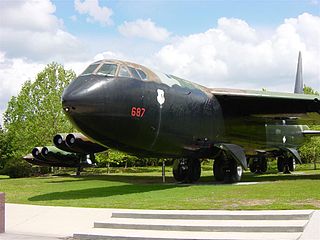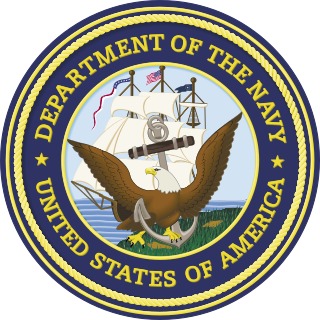Justifications
| | This section is empty. You can help by adding to it. (January 2013) |
The 1993 Base Realignment and Closure Commission preliminary list was released by the United States Department of Defense in 1993 as part of the Base Realignment and Closure Commission. It recommended closing 33 major United States military bases.
Chairman: Jim Courter Commissioner: CAPT Peter B. Bowman, USN (Ret) Commissioner: Beverly B. Byron Commissioner: Rebecca G. Cox Commissioner: GEN H.T. Johnson, USAF (Ret) Commissioner: Harry C. McPherson Jr. Commissioner: Robert D. Stuart Jr. [1]
| | This section is empty. You can help by adding to it. (January 2013) |
Major facilities slated for closure included: [2]

McCoy AFB is a former U.S. Air Force installation located 10 miles (16 km) southeast of Orlando, Florida. It was a training base during World War II. From 1951 to 1975, it was a frontline Strategic Air Command (SAC) base during the Cold War and Vietnam War. It was Orlando's biggest employer and economic backbone prior to the opening of Walt Disney World in 1971.
Base Realignment and Closure (BRAC) was a process by a United States federal government commission to increase the efficiency of the United States Department of Defense by coordinating the realignment and closure of military installations following the end of the Cold War. Over 350 installations have been closed in five BRAC rounds: 1988, 1991, 1993, 1995, and 2005. These five BRAC rounds constitute a combined savings of $12 billion annually.

Naval Air Station Jacksonville is a large naval air station located approximately eight miles (13 km) south of the central business district of Jacksonville, Florida, United States.

Naval Air Station Alameda was a United States Navy Naval Air Station in Alameda, California, on San Francisco Bay.

McClellan Air Force Base (1935–2001) is a former United States Air Force base located in the North Highlands area of Sacramento County, 7 miles (11 km) northeast of Sacramento, California.

The 2005 Base Realignment and Closure Commission preliminary list was released by the United States Department of Defense on May 13, 2005. It was the fifth Base Realignment and Closure ("BRAC") proposal generated since the process was created in 1988. It recommended closing 22 major United States military bases and the "realignment" of 33 others. On September 15, 2005, President George W. Bush approved the BRAC Commission's recommendations, leaving the fate of the bases in question to the United States Congress. Congress had a maximum of 45 days to reject the proposal by passing a joint resolution of disapproval, or the recommendations automatically enter into effect. Such a resolution was introduced to the House of Representatives on September 23, 2005, by Rep. Ray LaHood (R-IL). The House took up debate of the resolution on October 26, 2005. The resolution failed to pass by a 324-85 margin, thereby enacting the list of recommendations. The Secretary of Defense was required to begin implementing the recommendations by September 15, 2007, and to complete implementation no later than September 15, 2011.

Parks Reserve Forces Training Area (PRFTA), commonly known as Camp Parks, is a United States Army base located in Dublin, California, that is currently an active military and training center for U.S. Army Reserve personnel to be used in case of war or natural disaster.

Griffiss Air Force Base is a former United States Air Force installation in the northeastern United States, located in Central New York state at Rome, about fifteen miles (25 km) northwest of Utica.

The Naval Air Warfare Center Training Systems Division (NAWCTSD) is an Echelon IV command of the United States Navy, reporting to the Commander, Naval Air Warfare Center - Aircraft Division (NAWCAD) at NAS Patuxent River, Maryland. NAWCTSD is located in Orlando, Florida in the Central Florida Research Park, adjacent to the University of Central Florida (UCF). The facility is a part of a larger military installation within the Central Florida Research Park known as Naval Support Activity Orlando.

United States Naval Districts is a system created by the United States Navy to organize military facilities, numbered sequentially by geographic region, for the operational and administrative control of naval bases and shore commands in the United States and around the world. Established in 1903, naval districts became the foundational system for organizing U.S. naval forces ashore during the 20th century. The term "Naval" forces includes United States Marine Corps and current United States Coast Guard units.
A joint base (JB) is a base of the armed forces of the United States utilized by multiple military services; one service hosts one or more other services as tenants on the base. In most cases, joint bases have interservice support agreements (ISSAs) to govern how the host provides services to the tenants.
The 1988 Base Realignment and Closure Commission preliminary list was released by the United States Department of Defense in 1988 as part of the Base Realignment and Closure Commission. It recommended closing 17 major United States military bases.
The preliminary 1991 Base Realignment and Closure Commission list was released by the United States Department of Defense in 1991 as part of the ongoing Base Realignment and Closure Commission. The list recommended closing 28 major United States military bases throughout the nation. This was the last Base Realignment and Closure Commission prior to the dissolution of the Soviet Union ending the Cold War.
The 1995 Base Realignment and Closure Commission preliminary list was released by the United States Department of Defense in 1995 as part of the Base Realignment and Closure Commission. It recommended closing 32 major United States military bases.

Homestead Air Reserve Base, previously known as Homestead Air Force Base is located in Miami–Dade County, Florida to the northeast of the city of Homestead. It is home to the 482nd Fighter Wing of the Air Force Reserve Command's Tenth Air Force, as well as the headquarters of Special Operations Command South.

California during World War II was a major contributor to the World War II effort. California's long Pacific Ocean coastline provided the support needed for the Pacific War. California also supported the war in Europe. After the Japanese attack on Pearl Harbor on December 7, 1941, most of California's manufacturing was shifted to the war effort. California became a major ship builder and aircraft manufacturer. Existing military installations were enlarged and many new ones were built. California trained many of the troops before their oversea deployment. Over 800,000 Californians served in the United States Armed Forces. California agriculture, ranches and farms were used to feed the troops around the world. California's long coastline also put the state in fear, as an attack on California seemed likely. California was used for the temporary and permanent internment camps for Japanese Americans. The population grew significantly, largely due to servicemen who were stationed at the new military bases/training facilities and the mass influx of workers from around the U.S. in the growing defense industries. With all the new economy activity, California was lifted out of the Great Depression. Over 500,000 people moved to California from other states to work in the growing economy. California expanded its oil and mineral production to keep up with the war demand.
Alameda Naval Hospital was a large US Navy medical treatment facility in Alameda, California on 77 acres (31 ha). The Naval Hospital opened in 1941 to serve World War II troops and their families. The main building was 150,000 square feet with three stories. The hospital was maintained as a state-of-the-art hospital until it closed in 1975. The hospital was near to and supported Naval Air Station Alameda. Alameda Naval Hospital also had a dental unit that operated until closure. By 1960 the hospital was down-sized and used now as a depot to distributing medical supplies and equipment to Navy ships and nearby bases, as the hospital was next to the railroad and truck transportation terminals. Most Navy personnel in need of care were sent to Naval Hospital Oakland starting in 1960. In 1975 the hospital and dental unit closed and only the depot used the building, now called Navy Fleet Industrial Supply Center or Navy FISC Administration Building/Alameda FISC building. The closure of FISC on April 25, 1997, was per Base Realignment and Closure procedures ordered by the US Congress and the United States Department of Defense. The site was abandoned and a March 29, 2009 fire gutted the building and two nearby Army buildings. After the closure the building was used sometimes for urban assault training. Because the building was abandoned for many years it became an Urban legend site. The site of the Alameda Naval Hospital started as a 1930s Army Air Corp base called Benton Field, the land was turned over to the Navy in 1941 for the hospital. The Catellus Development Corporation had planned a development project on the property but canceled. In 2013 Vista Environmental, a hazmat team removed most of the building. On October 19, 2019, the city approved a development plan to use 17 acres (6.9 ha) of the former Naval Hospital land. Catellus Development Corporation has the right now to build on the land. The plan calls for 354 residences, include 30 single-family homes, 93 townhouses, 138 micro townhouses and 96 standard apartments. The new homes are called Bay37 by Pulte Homes.

The Alameda Naval Air Museum is an aviation museum located in Alameda, California and focused on the history of Naval Air Station Alameda.
{{cite web}}: CS1 maint: archived copy as title (link)